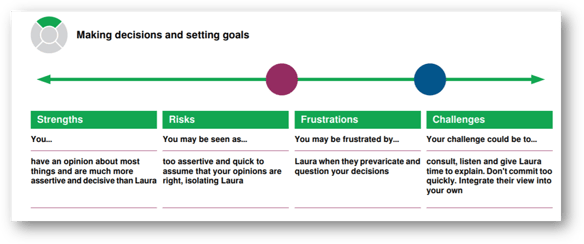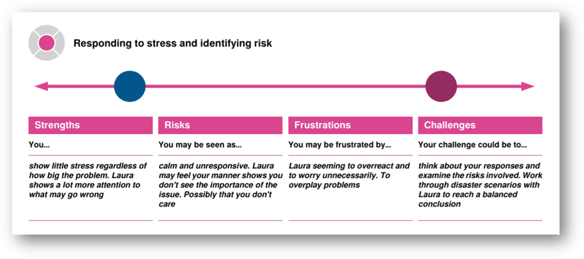If you use Facet5 every day in your workplace, you’ll be aware that the Spotlight report can shed some valuable light on how you undertake key aspects of your job. From making decisions and setting goals to assessing risk, the Spotlight report links your facet data to these common behaviours and describes the strengths, risks, frustrations, and challenges you may experience when working with others.
At work, there may be some key relationships where it might be beneficial for us to become more familiar with each other's strengths and risks; this could be team members who work closely together, a coach/coachee relationship, or, quite commonly, a manager/direct report relationship. Sometimes you know you both work differently but just can’t find a language to articulate it!
Spotlight expresses the data of the five factors as the following behavioural domains:
Making Decisions and Setting Goals (Will)
Engaging and Consulting with Others (Energy)
Focusing on People and Tasks (Affection)
Managing Your Work and Commitments (Control)
Responding to Stress and Identifying Risk (Emotionality)
When two sets of Spotlight descriptions are compared, it is possible to see where both parties are similar or different. The Coaching Affinity Report brings together two profiles and outlines the likely strengths, risks, frustrations and challenges.
Here are a few examples:

This example shows how the subject of the report works with Laura, who could be a colleague, coachee or direct report (the report uses ‘coach’ and ‘client’ as its terminology, but this doesn’t have to be the case). Each subfactor is examined and represented beneath each of the five areas. Here we can see the outcome of different levels of Determination; one being far more direct in their opinions and quicker to decide than the other. In order to get the most from Laura and forge a productive relationship, they would need to be more accommodating and give more time for her to share her views.
 In the example above, we can see the effect of different scores for Tension, a subfactor of Emotionality. There is potential frustration here in how differently both may react in stressful situations; one seemingly underreacts whilst the other may respond in quite the opposite way. Using the descriptions here can bring the subject to attention using language which accessible, safe and commonly understood.
In the example above, we can see the effect of different scores for Tension, a subfactor of Emotionality. There is potential frustration here in how differently both may react in stressful situations; one seemingly underreacts whilst the other may respond in quite the opposite way. Using the descriptions here can bring the subject to attention using language which accessible, safe and commonly understood.
But how’s about when two people are more alike?

Here, the subfactor of Adaptability has similar scores for both people, indicated by the blue and purple dots. There are nonetheless challenges when working together because there is double the risk of having the same blindspot. By simply sharing this information, they will become more aware of what they both need to work on, be on the lookout for this, and maybe even be one another’s conscience!
We use the term ‘affinity’ to describe the chemistry between two colleagues; this means that there is rapport between them, an environment of both support and challenge plus importantly, an overall level of trust. The Spotlight Coaching Affinity report allows two individuals to use the language of Facet5 and examine where they will both compliment each other but also where the relationship will require more work; perfect for coaching, manager/peer relationships, peer to peer and even client/customer interactions.
And with Valentine’s Day in mind…you may even be able to answer the eternal question do opposites really attract?
How would you like to start a conversation? Click on the icons below, or use our interactive video tool.